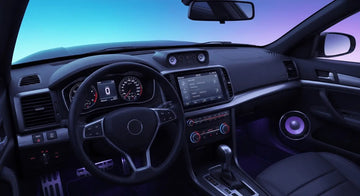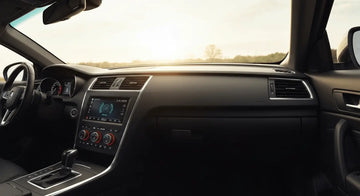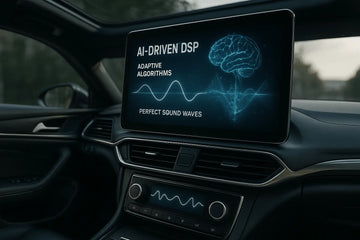Welcome to the world of car audio tuning, where expert recommendations can help you achieve the best sound quality for your audio system. Proper car audio tuning is essential whether you're a music enthusiast or enjoy a high-quality driving experience.
In this blog, we will explore the importance of car audio tuning and the importance of either finding a good car audio tuner or learning the process yourself. We will discuss the factors that affect audio performance, the components of a car audio system, the role of equalizers, and provide expert tips and step-by-step guidance on tuning your car's stereo system. So, let's dive in and unlock the secrets to achieving optimal sound in your car!
The Importance of Car Audio Tuning

When it comes to car audio, sound quality is vital. A well-tuned audio system delivers the best sound and enhances your overall driving experience. Car audio tuning involves adjusting various settings and components to ensure the audio system performs at its best. By tuning your car's audio system, you can eliminate distortions, enhance clarity, and maximize the potential of your car's audio system. It allows you to experience the full range of frequencies in your music, correct imbalances in volume and tone, and create a more enjoyable listening experience.
Reasons to Tune Your Car's Audio System
- Tuning eliminates distortions and enhances clarity in sound, allowing you to enjoy the best sound possible in your car.
- Proper tuning helps maximize the potential of your car's audio components, ensuring you get the best sound quality.
- It ensures that you experience the full range of frequencies in your music, from deep bass notes to high treble boosts, for a well-balanced audio experience.
- Tuning can correct imbalances in volume and tone across speakers, providing a consistent soundstage throughout your car.
- A well-tuned audio system delivers the best sound and enhances your overall driving experience, making those long drives more enjoyable and immersive.
Factors Affecting Car Audio Performance

- Environmental factors such as road noise, vibrations, and air quality can impact audio performance in a car. By tuning your car audio system, you can minimize the effects of these factors and ensure optimal sound quality.
- The quality of audio components and installation also plays a significant role in audio performance. Investing in high-quality car speakers, amplifiers, and subwoofers and ensuring proper installation can enhance sound quality.
- Improper tuning settings can lead to poor sound quality. Adjusting the settings, such as bass, midrange, treble frequencies, balance, fade, and equalizer settings, can optimize audio performance.
- The size of your vehicle and its interior acoustics can impact audio performance. Tuning your car audio system considers these factors and adjusts the sound settings accordingly.
- Correcting these factors through tuning can significantly enhance sound quality, providing a more immersive and enjoyable listening experience in your car.
Understanding Audio System Components

Before diving into the art of car audio tuning, it's essential to understand the components that make up your car's audio system. Each component plays a vital role in delivering high-quality audio output from the head unit to speakers and amplifiers. Let's look at these components and how they work together to create an immersive sound experience in your car.
Detailed Overview of Car Stereo Components
- Head Unit: also known as the car stereo, is the control center for your audio system. It allows you to control audio sources, such as radio, CD, or Bluetooth, and adjust basic settings like volume, bass, treble, fade, and balance.
- Amplifiers: Also called amps, boost the audio signal to power your speakers and subwoofers. They ensure that the audio signal is strong enough to produce high-quality sound.
- Speakers are the primary audio output device in a car audio system. They reproduce sound with different frequency responses, delivering low, midrange, and high frequencies.
- Tweeters: specialized speakers focusing on high-frequency sounds, such as vocals and cymbals, adding clarity and detail to the audio output.
- Subwoofers: dedicated speakers that reproduce deep bass frequencies, providing a rich and full sound experience.
- Crossover: a device that splits the audio signal into different frequency bands, directing low frequencies to the subwoofer, midrange frequencies to the speakers, and high frequencies to the tweeters. It ensures a balanced distribution of frequencies across different speakers.
Role of Equalizers in Audio Performance
- Equalizers, or EQs, play a crucial role in audio performance. They allow you to adjust the frequency response of your audio system, fine-tuning bass, midrange, and treble frequencies according to your preferences.
- The equalizer settings can correct acoustic imbalances in your vehicle, compensating for factors like road noise or interior acoustics.
- Adjusting the equalizer settings allows you to achieve a balanced and clear soundstage, where each instrument and vocalist occupies its own space in the audio image.
- Proper equalizer settings can enhance bass response, allowing you to enjoy deep and powerful bass notes and treble boosts for crystal-clear highs.
- Utilizing equalizers effectively can significantly enhance the overall audio experience, making your favorite songs sound even better in your car.
The Art of Proper Car Audio Tuning

Now that we understand the components of a car audio system, let's delve into the art of car audio tuning. Proper tuning involves adjusting various settings, finding the right balance, and fine-tuning your audio system to achieve the best sound quality. By mastering the art of car audio tuning, you can unlock the full potential of your audio system and enjoy a truly immersive listening experience on the road.
Step-by-step Guide to Tune Your Car's Stereo System
- Start by setting the volume to a comfortable listening level, ensuring the sound is neither soft nor loud.
- Adjust the equalizer settings to balance bass, midrange, and treble frequencies according to your preference. Experiment with different settings to find the perfect sound for your ears.
- Fine-tune the volume, fade, and balance settings to ensure uniform sound distribution across speakers, creating a balanced soundstage.
- Test your audio system with different music genres to evaluate its performance and make any necessary adjustments to the equalizer settings.
- Regularly revisit your tuning settings to maintain optimal audio quality, as external factors like temperature and speaker aging can affect sound reproduction.
Expert Tips for Soundstage Creation
- Positioning speakers correctly plays a vital role in creating a realistic soundstage. Place front speakers at ear level, aligning them with the driver and passenger for an immersive listening experience.
- Adjust time alignment settings to enhance sound imaging and depth perception, ensuring that the audio appears from the correct location, regardless of speaker placement.
- Utilize soundproofing materials, such as acoustic damping, to reduce external noise interference, allowing you to appreciate the audio quality of your car entirely.
- Experiment with crossover settings to find the perfect blend between front and rear speakers, achieving a seamless transition in sound output.
- Creating a well-defined soundstage is vital to a captivating and immersive audio experience, where each instrument and vocal is placed precisely, enhancing your overall listening pleasure.
Adjusting Audio Based on Preferences

To truly personalize your car audio experience, adjusting the audio settings based on your preferences is essential. Fine-tuning the bass, treble, and other audio settings allows you to tailor the sound to suit your taste and the genre of music you're listening to. Whether you prefer a bass-heavy sound for hip-hop or a more balanced sound for jazz, adjusting the audio settings allows you to create a tailored listening experience that enhances your enjoyment of music on the road.
Tips to Adjust Your Subwoofer
- To enhance bass frequencies and achieve a fuller sound experience, adjust the settings of your subwoofer. Experiment with higher or lower bass notes to find the right balance.
- Fine-tune the subwoofer settings to achieve optimal bass notes without overpowering the rest of the audio spectrum. This balance ensures an immersive sound experience without distortion.
- Adjust the subwoofer levels to balance the overall sound quality of your audio system, ensuring that the bass complements the other frequencies without overpowering them.
- Experiment with the settings of your subwoofer to find the correct bass response for different music genres, allowing you to enjoy the depth and richness of low frequencies fully.
- By tweaking subwoofer controls, you can significantly improve the sound quality of your audio system, creating a more immersive and enjoyable listening experience in your car.
Getting the Right Amount of Bass in Your Music
- Achieving the right bass in your music is crucial for an enjoyable listening experience. Too much bass can overpower other frequencies, while too little bass can make the sound feel lacking.
- Enhance bass frequencies without overwhelming the rest of the audio spectrum, ensuring a balanced and immersive sound experience.
- Optimize bass levels to achieve a rich listening experience where bass notes are felt, adding depth and impact to your favorite songs.
- Adjust bass settings to suit different music genres, as some genres may require more bass emphasis while others may benefit from a more balanced approach.
- Fine-tuning bass notes in your audio system allows you to get the right amount of bass, ensuring that every song sounds its best.
Tools Required for Car Audio Tuning

You'll need a few essential audio tuning tools to achieve optimal sound quality and fine-tune your car audio system. These tools help measure, adjust, and optimize the performance of your audio system. Let's look at the tools you'll need to unleash the full potential of your car's audio system.
A Comprehensive List of Audio Tuning Tools
- RTA (Real-Time Analyzer): A tool that measures and analyzes audio frequencies in real time, allowing you to identify and correct any frequency imbalances.
- Microphone: A high-quality microphone is essential for accurately measuring sound levels and frequencies in your car. It helps determine the quality of sound reproduction and identifies any areas needing tuning.
- Mobile Apps: There are various mobile apps available that provide audio analysis, equalizer settings, and sound tuning capabilities, making it easy to fine-tune your audio system from the convenience of your smartphone.
- DSP (Digital Signal Processor): A powerful tool that allows you to digitally control and adjust audio settings, providing precise tuning control for different audio frequencies.
- Laptop or Tablet: A laptop or tablet with audio tuning software can be used for advanced tuning adjustments, providing a visual interface for precise control over audio settings.
Using the Tools Effectively
- Mastering the art of using audio tuning tools effectively is crucial for achieving optimal sound quality. Understanding the functions and settings of each tool allows you to make precise adjustments to your audio system.
- Experiment with different tuning settings and measure their impact using a real-time analyzer (RTA) or microphone. This helps you fine-tune your car audio system setup to achieve your desired sound quality.
- Utilize mobile apps with equalizer features to adjust audio settings on the go, tailoring the sound to your preferences and specific listening environments.
- Please use a digital signal processor (DSP) 's advanced tuning capabilities. Explore different settings, such as crossover frequencies and time alignment, to optimize sound quality.
- By effectively using audio tuning tools, you can unleash the full potential of your car audio system, ensuring optimal sound quality and an immersive audio experience on the road.
Professional Assistance for Car Audio Tuning

While car audio tuning can be done independently, there are times when seeking professional assistance can be beneficial. Experienced professionals can provide expert advice and advanced tuning techniques and ensure that your audio system is optimized to its fullest potential. Let's explore when it's best to seek professional help and the benefits it offers.
When to Seek Professional Help?
- If you're new to car audio tuning, seeking professional help is highly recommended. Professionals have experience working with different car audio systems, top brands, and tuning techniques, ensuring optimal sound quality.
- When installing a new car stereo system, professional tuning can enhance its overall sound quality, maximizing its capabilities. Professionals can fine-tune the audio settings, balance the sound, and ensure your new speakers, amplifiers, and subwoofers perform at their best.
- Complex audio tuning tasks, such as adjusting crossover frequencies, time alignment, and equalizer settings, may require expert assistance. Professionals have the knowledge and tools to handle these advanced tuning adjustments, ensuring precise audio tuning.
- If you're not satisfied with the sound quality of your car audio system or are experiencing any audio-related issues, seeking professional help can diagnose and rectify the problems, providing you with the best audio experience.
- Professionals can offer expert advice on system upgrades and recommend the best components for your car audio system, ensuring you achieve top-notch sound quality and an immersive audio experience.
Benefits of Professional Audio Tuning
- Professional audio tuning elevates the overall sound quality of your car audio system. Experts have the knowledge, experience, and tools to fine-tune each component, ensuring optimal performance and clarity in sound reproduction.
- Expert tuning provides a balanced and immersive sound experience, creating a soundstage where every instrument and vocal occupies space, enhancing the overall audio quality.
- Professional audio tuning maximizes the potential of your car audio system, ensuring that you get the best sound quality from your speakers, subwoofers, and amplifiers.
- With professional tuning, you can achieve precise audio settings, custom-tailored to your preferences and specific listening environment, providing a truly personalized audio experience.
- Benefit from precise tuning that maximizes your listening pleasure, allowing you to enjoy your favorite music with enhanced clarity, detail, and depth.
Achieving Optimal Sound with Proper Tuning

A properly tuned car audio system ensures optimal sound quality, balance, and clarity. By mastering the art of car audio tuning, you can achieve an optimal sound that enhances your overall audio experience. Let's explore how adjusting and maintaining your tuned audio system can improve your car's sound quality.
- Making adjustments to your audio system is an ongoing process. Regularly monitor and fine-tune settings to maintain optimal sound quality, ensuring your audio system consistently performs at its best.
- Focus on adjustments that improve clarity, balance, and loudness. Fine-tuning bass, treble, fade, balance, and equalizer settings can bring out the best in your audio system, enhancing the overall sound quality.
- Experiment with different settings to find the right balance for your audio system, allowing each frequency range to shine and bringing clarity to every instrument and vocal.
- Regular adjustments to your audio system ensure it performs optimally, delivering the best sound quality in different listening environments and whenever you hit the road.
- You can achieve clarity, loudness, and the best audio performance by actively maintaining and tweaking your tuned audio system, creating an immersive listening experience in your car.

- Regularly check and clean your car audio system to ensure optimal performance. Dust, debris, and vibrations can affect sound quality, so keeping your system clean and free from obstructions is essential.
- Adjust the settings of your audio system as per your listening preferences and the type of music you're listening to. Fine-tuning bass, treble, and equalizer settings allows you to tailor the sound to your taste.
- Invest in high-quality audio components that can enhance the sound quality of your car's audio system. Upgrading speakers, subwoofers, and amplifiers can significantly affect sound reproduction.
Frequently Asked Questions

Can you tune a car audio system?
You can tune a car audio system to enhance sound quality. Tuning involves adjusting settings such as the equalizer, bass, treble, balance, and fade to optimize the audio performance.
It's about finding the right balance to eliminate distortions, enhance clarity, and ensure a rich, immersive listening experience. While basic tuning can be done by individuals with a good ear for sound, complex tuning or achieving professional-grade audio quality might require expert assistance or specialized tools.
What should bass and treble be set at in a car?
The ideal settings for bass and treble in a car depend on personal preference, the type of music being played, and the acoustics of the car's interior. A good starting point might be to set both bass and treble at the midpoint and then adjust according to your taste. For a more balanced sound, you might prefer to keep both settings near the midpoint, while for more vibrant and dynamic audio, you could increase the treble.
Similarly, if you enjoy music with a strong beat or deep tones, increasing the bass can enhance your listening experience. Remember, the goal is to achieve a well-rounded sound that complements a variety of music genres without causing distortions.
How can I make my factory car stereo sound better?
Improving the sound quality of a factory car stereo involves several strategies. Start with basic tuning adjustments, such as tweaking the equalizer settings better to match your music preferences and the car's acoustics. Consider upgrading components like speakers for clearer sound or adding a subwoofer for deeper bass. Soundproofing the car interior can also reduce external noise and vibrations, allowing for a clearer audio output.
Regular maintenance, such as cleaning speakers and checking for loose connections, can also contribute to maintaining optimal sound quality. For advanced improvements, using tools like a Digital Signal Processor (DSP) can provide more precise control over audio settings, but you might want to consult a professional for such upgrades.
Conclusion
In conclusion, mastering the art of car audio tuning is a crucial step toward enhancing your driving experience. By understanding the components and tuning techniques and utilizing the right tools, you can achieve optimal sound quality tailored to your preferences.
Whether you prefer a rich bass or a balanced soundstage, tuning your car's audio system can make a significant difference. Remember, seeking professional assistance and regularly maintaining your tuned audio system ensures long-lasting performance. Embrace the world of car audio tuning, and enjoy the journey of creating your personalized audio oasis on the road.






